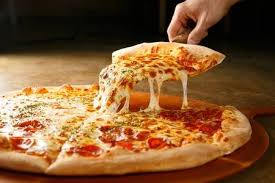School Lunch Week: Pizza
Listen to the Recess! Clip
| Author | Malini Roy |
| Air Date | 10/12/2004 |

School Lunch Week: Pizza Transcript
All over America, school lunches and pizza seem to go hand in hand. But few of us realize that this favorite of children and grown-ups alike has had a long and convoluted history down the millennia. Pizza as we know it is flat, circular bread baked with cheese and tomatoes and was created in Italy in the 16th century. Its antecedents existed as early as the 6th century BC, when Persian soldiers took to baking flat bread on their shields during long marches, topping it with cheese and dates.
In 1889, when Raffaele Esposito of Naples presented pizza to Queen Margarita, the colors of his dish corresponded to those of the Italian flag: the green of basil, the white of mozzarella cheese and the red of tomatoes gave this dish a patriotic significance. But Esposito could not have imagined then that some fifty years later, American GIs, returning home from World War II, would start a craze for this dish they had first tasted in Italy. Since then, pizza has become a quintessentially American food. Although there are many regional preferences, the standard toppings include pepperoni, Italian sausage and mushrooms, followed by chicken, shrimp, anchovies, and by onions, olives, and spinach. For those with more exotic palates, there’s pineapple, mango, and just about any other kind of topping you can think of.
In the 1980s, chains like Dominos and Pizza Hut went international, and going global also meant going local. In Brazil, for instance, pizza is topped with strawberry, banana, and mango chutney. In India, they are topped with chicken tandoori, and in France with fresh, sweet cream. Red herring is a favorite topping in Russia; Costa Ricans like coconut, while in many South Asian countries curry plays favor. The number one topping in the Netherlands is grilled lamb; in Japan this honor goes to mayonnaise, potato chunks, and squid.
In America, pizza is eaten informally, but internationally, it is not generally considered a fast food. In fact, in most of Europe and much of Asia, this exotic Western dish is eaten quite genteelly with knife and fork. In many countries, the imported ingredients that are used to make pizza jettison it into a pretty expensive meal. So, ordering pizza for a children’s party, as Americans often do, becomes something of a status symbol, usually reserved for the well-to-do.